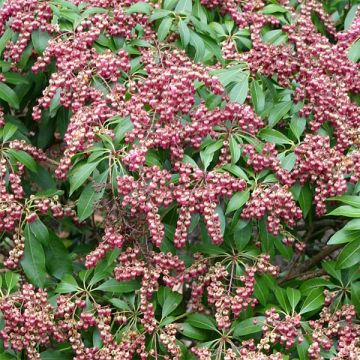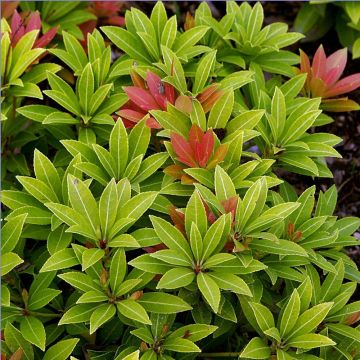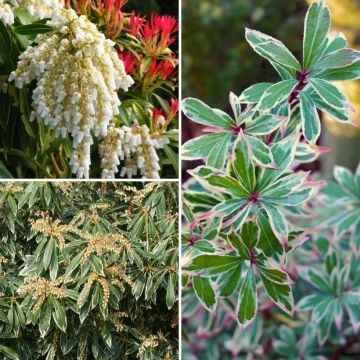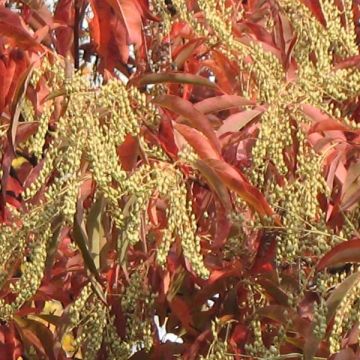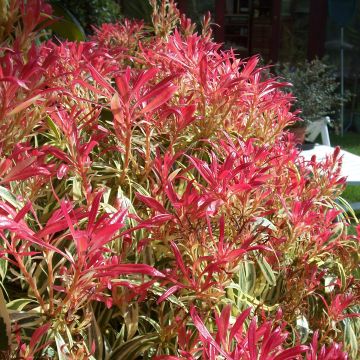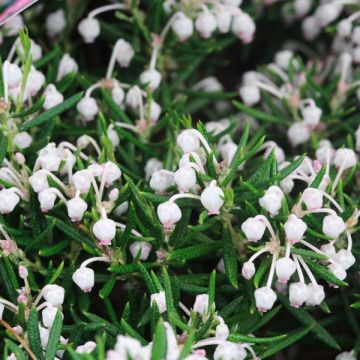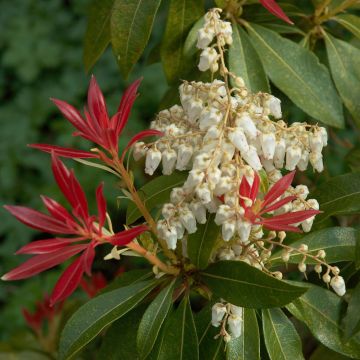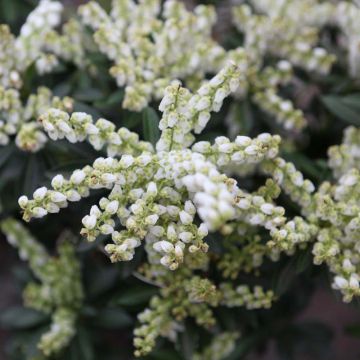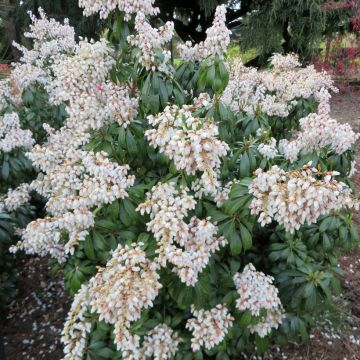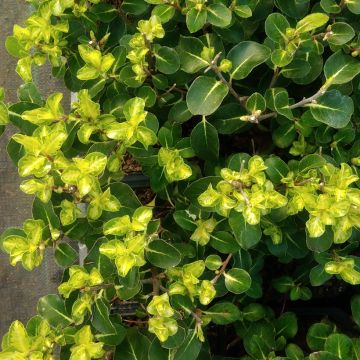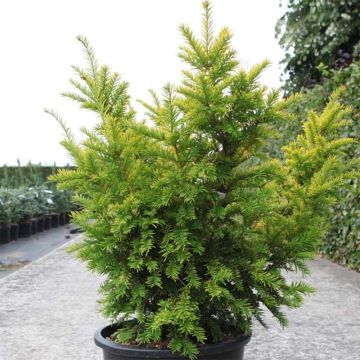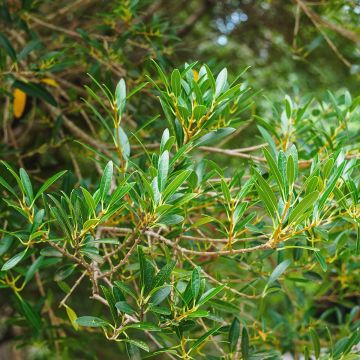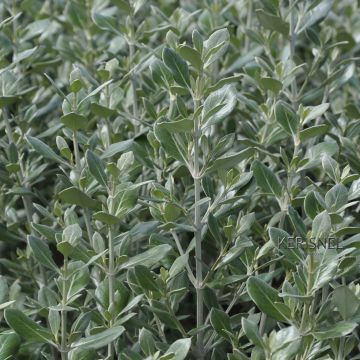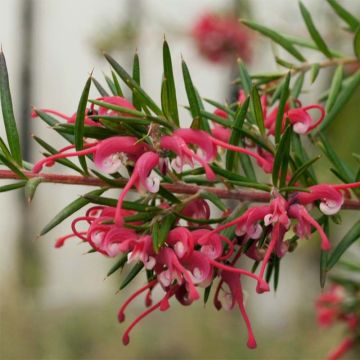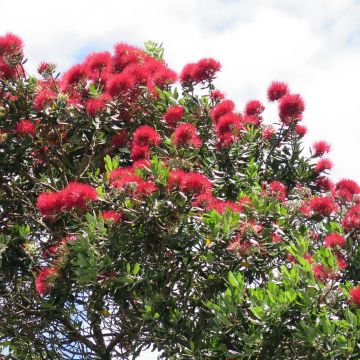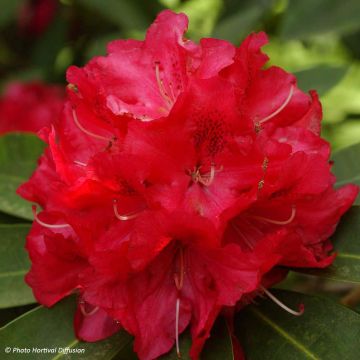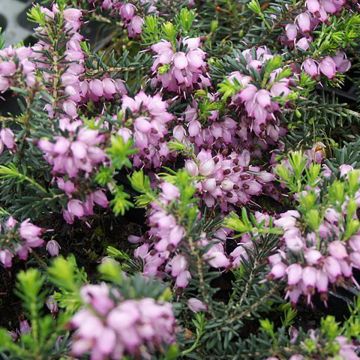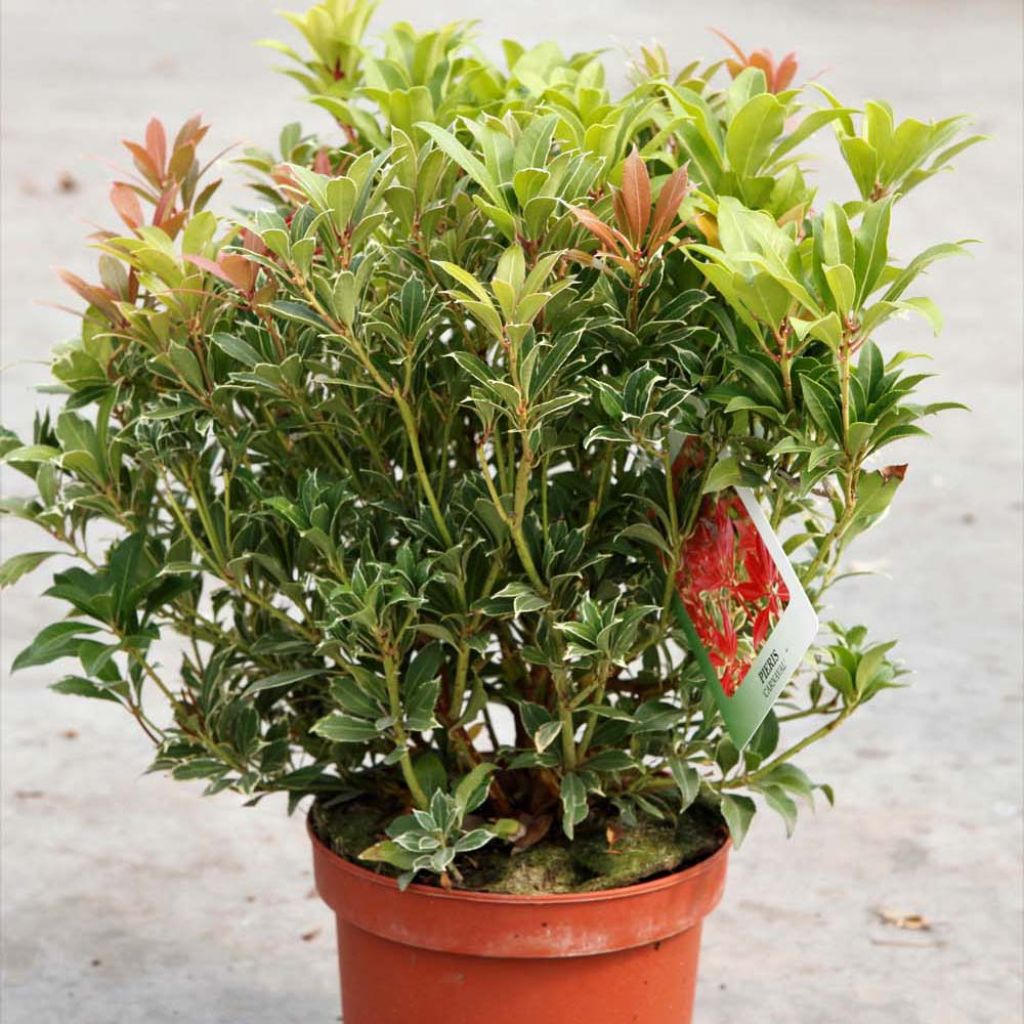

Andromède du Japon - Pieris Carnaval
Pieris japonica Carnaval - Japanese Andromeda
Pieris japonica Carnaval
Japanese Andromeda, Japanese Pieris, Lily-of-the-Valley Bush
A lovely little bush that I would put in a pot in front of my entrance instead of a Japanese maple that didn't withstand the very hot summer we had. A beautiful green and white foliage. I haven't seen it flower yet, so I can't judge.
Philippe, 06/11/2022
This item cannot be shipped to the selected country
Delivery charge from €5.90
More information
Schedule delivery date,
and select date in basket
This plant carries a 24 months recovery warranty
More information
We guarantee the quality of our plants for a full growing cycle, and will replace at our expense any plant that fails to recover under normal climatic and planting conditions.
From €5.90 for pickup delivery and €6.90 for home delivery
Express home delivery from €8.90.

Does this plant fit my garden?
Set up your Plantfit profile →
Description
Pieris japonica 'Carnival' is a recent variety of Japanese Andromeda that will charm with its tricoloured foliage at the beginning of the season. This bush is evergreen and interesting throughout the year, primarily because of its shiny young foliage, a beautiful bronze-pink to red when it first sprouts, appearing just before its beautiful flowering in panicles of small white-cream flowers. The rest of the year it displays an elegant glossy foliage, finely edged with white-cream on a green background, and a pretty habit that is rather upright. Superb in a large pot on the terrace or in a shrub bed, always in partial shade and in a non-chalky soil.
Pieris belong to the Ericaceae family, like heathers and rhododendrons. They are shrubs that prefer acidic or at least non-calcereous soil, with evergreen foliage and new shoots that take on pink or coppery hues, accompanied by lovely flowering in pendulous clusters of small bells. Very easy to grow, they appreciate a light, fresh, and acidic soil, in a partially shaded or possibly sunny location as long as it is not exposed to scorching sun. Varieties derived from Pieris japonica are quite hardy once established.
The 'Carnival' variety of Japanese Andromeda is a mutation of the cultivar 'Mountain Fire', selected in 1996 in the Netherlands. It has a slightly upright, bushy habit, reaching approximately 1.5 m (5 ft) in height and 1.25 m (4 ft) in spread at maturity. Its growth is slow. Its small, glossy, lanceolate leaves are initially bright green and then more bluish, with a fine white-cream margin, and are largely tinged with pink in winter, then bronze-coppery-pink in spring. Its cream-white blooms are slightly fragrant, composed of drooping 12 cm (4.5 in) clusters filled with small urn-shaped flowers, and is preceded by highly decorative pink buds in winter. Flowering takes place from April to May.
Slow-growing, pleasantly coloured, and bushy, 'Carnival' does not require pruning, demands very little maintenance, and is perfect for small gardens in pots and containers, in rockeries, or as a border plant. A superb evergreen bush that is a must-have for acidic, moist soil, it will naturally blend with rhododendrons, camellias and heathers, surrounded by a bed of hellebores, ferns, and Pernettya.
Report an error about the product description
Pieris japonica Carnaval - Japanese Andromeda in pictures
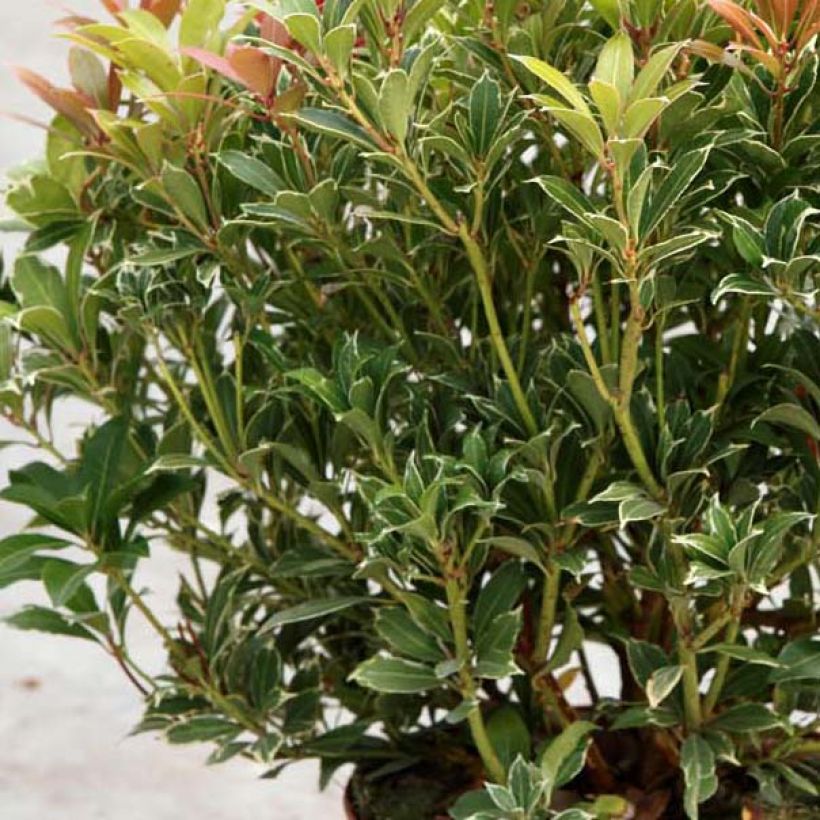

Plant habit
Flowering
Foliage
Botanical data
Pieris
japonica
Carnaval
Ericaceae
Japanese Andromeda, Japanese Pieris, Lily-of-the-Valley Bush
Cultivar or hybrid
Other Pieris
Planting and care
Pieris japonica grows in acidic but rather fertile soil. Using only commercial ericaceous compost, often poor quality, is not recommended for planting. Instead add some to soil that is clayey or neutral to slightly chalky, along with a low-pH substrate such as composted bark; this will also help to lighten it. Pieris require non-scorching (morning) sun or partial shade, and protection from cold drafts. They prefer soil that remains moist but well-drained. Good mulching (with pine bark, for example) can help retain soil moisture in summer. If you have heavy and/or chalky soil, cultivate your 'Carnaval' Japanese andromeda in a container, and preferably water it with non-calcereous water. Otherwise, it is a low-maintenance plant that rarely gets sick and should only be pruned in case of extreme necessity.
Planting period
Intended location
Care
-
, onOrder confirmed
Reply from on Promesse de fleurs
Evergreen shrubs
Haven't found what you were looking for?
Hardiness is the lowest winter temperature a plant can endure without suffering serious damage or even dying. However, hardiness is affected by location (a sheltered area, such as a patio), protection (winter cover) and soil type (hardiness is improved by well-drained soil).

Photo Sharing Terms & Conditions
In order to encourage gardeners to interact and share their experiences, Promesse de fleurs offers various media enabling content to be uploaded onto its Site - in particular via the ‘Photo sharing’ module.
The User agrees to refrain from:
- Posting any content that is illegal, prejudicial, insulting, racist, inciteful to hatred, revisionist, contrary to public decency, that infringes on privacy or on the privacy rights of third parties, in particular the publicity rights of persons and goods, intellectual property rights, or the right to privacy.
- Submitting content on behalf of a third party;
- Impersonate the identity of a third party and/or publish any personal information about a third party;
In general, the User undertakes to refrain from any unethical behaviour.
All Content (in particular text, comments, files, images, photos, videos, creative works, etc.), which may be subject to property or intellectual property rights, image or other private rights, shall remain the property of the User, subject to the limited rights granted by the terms of the licence granted by Promesse de fleurs as stated below. Users are at liberty to publish or not to publish such Content on the Site, notably via the ‘Photo Sharing’ facility, and accept that this Content shall be made public and freely accessible, notably on the Internet.
Users further acknowledge, undertake to have ,and guarantee that they hold all necessary rights and permissions to publish such material on the Site, in particular with regard to the legislation in force pertaining to any privacy, property, intellectual property, image, or contractual rights, or rights of any other nature. By publishing such Content on the Site, Users acknowledge accepting full liability as publishers of the Content within the meaning of the law, and grant Promesse de fleurs, free of charge, an inclusive, worldwide licence for the said Content for the entire duration of its publication, including all reproduction, representation, up/downloading, displaying, performing, transmission, and storage rights.
Users also grant permission for their name to be linked to the Content and accept that this link may not always be made available.
By engaging in posting material, Users consent to their Content becoming automatically accessible on the Internet, in particular on other sites and/or blogs and/or web pages of the Promesse de fleurs site, including in particular social pages and the Promesse de fleurs catalogue.
Users may secure the removal of entrusted content free of charge by issuing a simple request via our contact form.
The flowering period indicated on our website applies to countries and regions located in USDA zone 8 (France, the United Kingdom, Ireland, the Netherlands, etc.)
It will vary according to where you live:
- In zones 9 to 10 (Italy, Spain, Greece, etc.), flowering will occur about 2 to 4 weeks earlier.
- In zones 6 to 7 (Germany, Poland, Slovenia, and lower mountainous regions), flowering will be delayed by 2 to 3 weeks.
- In zone 5 (Central Europe, Scandinavia), blooming will be delayed by 3 to 5 weeks.
In temperate climates, pruning of spring-flowering shrubs (forsythia, spireas, etc.) should be done just after flowering.
Pruning of summer-flowering shrubs (Indian Lilac, Perovskia, etc.) can be done in winter or spring.
In cold regions as well as with frost-sensitive plants, avoid pruning too early when severe frosts may still occur.
The planting period indicated on our website applies to countries and regions located in USDA zone 8 (France, United Kingdom, Ireland, Netherlands).
It will vary according to where you live:
- In Mediterranean zones (Marseille, Madrid, Milan, etc.), autumn and winter are the best planting periods.
- In continental zones (Strasbourg, Munich, Vienna, etc.), delay planting by 2 to 3 weeks in spring and bring it forward by 2 to 4 weeks in autumn.
- In mountainous regions (the Alps, Pyrenees, Carpathians, etc.), it is best to plant in late spring (May-June) or late summer (August-September).
The harvesting period indicated on our website applies to countries and regions in USDA zone 8 (France, England, Ireland, the Netherlands).
In colder areas (Scandinavia, Poland, Austria...) fruit and vegetable harvests are likely to be delayed by 3-4 weeks.
In warmer areas (Italy, Spain, Greece, etc.), harvesting will probably take place earlier, depending on weather conditions.
The sowing periods indicated on our website apply to countries and regions within USDA Zone 8 (France, UK, Ireland, Netherlands).
In colder areas (Scandinavia, Poland, Austria...), delay any outdoor sowing by 3-4 weeks, or sow under glass.
In warmer climes (Italy, Spain, Greece, etc.), bring outdoor sowing forward by a few weeks.

































